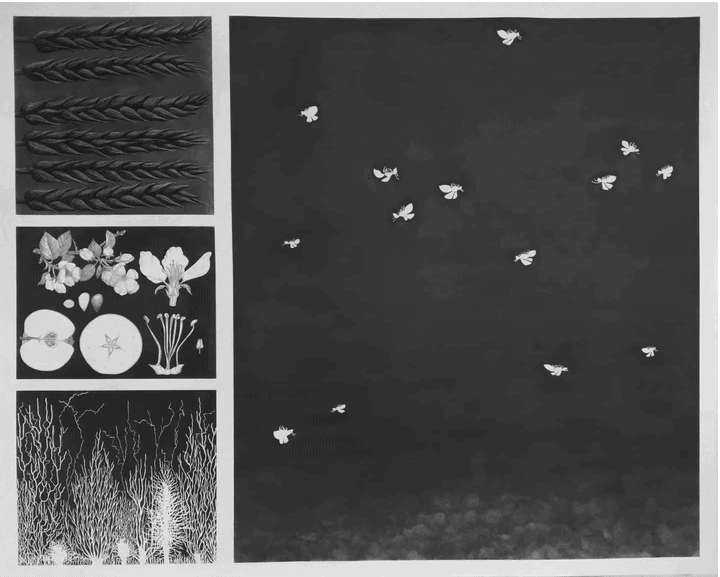Interrupted Ecosystem: Pollinators and Prairies, Charcoal, graphite, ash, & dirt on paper, 2019 (48 x 60”)
(I envisioned Endangered as an exhibition about our disconnection from nature and the inevitable tragic outcome, a continuation of Seton’s warnings. The invited artists created a variety of responses. Intended for the walls of the Seton Gallery, the show is presented in a series of blog postings. Images and text copyright belong to the individual artists. dlw)
Recorded interview of Nina Elder on May 27, 2020 at the Academy for the Love of Learning
This piece is part of a series that I did last May…looking at the close relationships, the interspecies relationships that keep ecosystems intact and what might happen if one of those species goes extinct. I was reading a lot of science and also land management research to understand the different ways that humans value these complex systems. They have value much beyond humans—but science and land management have their own set of values I was trying to understand in making these drawings. This series was looking at the relationship between wildland prairies and monoculture crops and pollinators.
Monoculture Crops
In the drawing you can see that the monoculture crops which I have depicted with wheats and genetically engineered apple blossoms and apple cross sections. Those are rendered in three- dimensional drawing. The roots of the prairie as well as the pollinators are depicted upside down and erased. I was thinking about these inversions that happen when you start to remove species. I was thinking about overlooked ecosystems in the places that I live. So often people don’t realize New Mexico is primarily grassland. One of the most diverse prairie systems in the world is the front range of the Rockies. We are in this incredible zone between the high Rocky Mountains ecosystem and these high plains and the lower desert.
We have incredible diversity but also a lot to lose from things like pesticides and monoculture crops.
Ghosted Out Species and Spaces
One of the strongest metaphors I’ve come up with or motifs are these ghosted out spaces and upside down voids that that I am starting to work with in my drawings. For me it impossible not to go out into nature and to think about that I am living with things now that will die. It’s almost like I get to say hello to right now to a future ghost. To me that is a very strong feeling of haunting and foreboding. I think some of that emotion that we feel about being haunted by future extinction is really important to focus on so that we might have a more complex emotional space about it and start to respond.
I get overwhelmed by science and data and the kind of objectivity of what comes out of climate science and the data around biological annihilation. To start having a more emotional response is so motivating. Saying hello to those ghosts and understanding them in our midst is what I am trying to do.
Art can hold those feelings of devastation in a beautiful space. Art is better at being a container for paradox than anything else. (We) can be bolstered by beauty and face the horror. Susan Sontag said to the question of Why art?: Let the beauty of what we see overwhelm the horror of what we know.
I am interested in how we can look to natural rhythms, things that are so much bigger than humans and have that bring hope.

